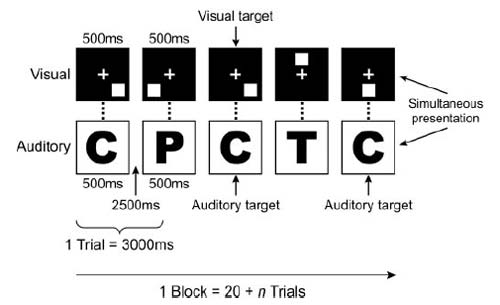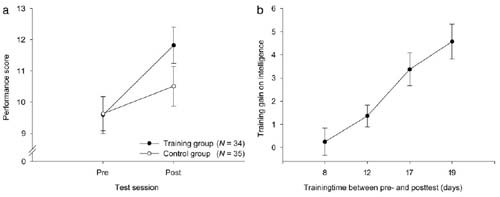Can Intelligence Be Trained? Martin Buschkuehl shows how
Today I had a great conversation with Martin Buschkuehl, one of the University  of Michigan Cognitive Neuroimaging Lab researchers involved in the cognitive training study that has received much media attention (New York Times, Wired, Science News…) since late April, when the study was published at the Proceedings of the National Academy of Sciences.
of Michigan Cognitive Neuroimaging Lab researchers involved in the cognitive training study that has received much media attention (New York Times, Wired, Science News…) since late April, when the study was published at the Proceedings of the National Academy of Sciences.
Reference: Jaeggi, S. M., Buschkuehl, M., Jonides, J., & Perrig, W. J. (2008). Improving Fluid Intelligence With Training on Working Memory. Proceedings of the National Academy of Sciences of the United States of America, 105(19), 6829–6833 (You can read it here, with subscription).
Before you keep reading, let me clarify a couple of terms:
- “Working Memory” is the ability to hold several units of information in our minds and manipulate them in real time. For example, imagine I ask you to remember, and then say backwards, the 7 digits of my phone number.
- “Fluid intelligence” can be described as the ability to deal with new challenges and new problems, those that we encounter for the first time.
Dr. Buschkuehl, nice to talk to you. Can you first provide us with some context on your research?
My collaborator Susanne Jaeggi and I started our training work four years ago in the Lab of Prof. Walter Perrig at the University of Bern, Switzerland. Now we are both Post Docs in Prof. John Joindes Lab at the University of Michigan. We developed a complex computerized task and have tried it in a number of studies. We reported our results in two unpublished dissertations, but this is the first time it has been published in a peer-reviewed journal.
Could you please explain the training involved in this particular study?
We recruited 70 students aged around 26 years and set half of them on a challenging computer-based cognitive training regimen, based on the so-called “n‑back task.” This is a very complex working memory task that involves the simultaneous presentation of visual and auditory stimuli. The experimental group watched a series of screens on their computers, where a blue square appeared in various positions on a black background. Each screen appeared for half a second, with a 2.5 second gap before the next one appeared. While this happened, the trainees also heard a series of letters that were read out at the same rate. 
At first, students had to say if either the screen or the letter matched those that popped up two cycles ago. The number of cycles increased or decreased depending on how well the students performed the task. The students sat through about twenty-five minutes of training per day for either 8, 12, 17 or 19 days, and were tested on their fluid intelligence before and after the regimen using the Bochumer-Matrizen Test (this is a problem-solving task based on the same principle as the very well known Raven’s Advanced Progressive Matrices. However, it is more difficult and therefore especially suited for academic samples).
What were the results?
Participants in the experimental group did significantly better on the fluid intelligence test (which was not directly trained) than participants in the control group. Those in the control group had not gone through any training. The control group did improve slightly, but real “trainees” outperformed them (see Figure Xa). Furthermore, we found that the improvement was dose-dependent: the more they trained, the larger the gain on fluid intelligence.

Images: PNAS.
We just published a market report to cover the growing brain fitness software market. A common question we get is, “How are computerized programs like the one you used fundamentally different from, say, simply doing many crossword puzzles?
First, thank you for sending the report along. Fascinating to see what is starting to happen in this field.
In terms of why our program worked, I could say that the program has some inherent properties that are at least in this combination unique to our training approach. Our program is:
- Fully adaptive in real-time: The person using the program is truly pushed to his or her peak level all the time, thereby “stretching” the targeted ability.
- Complex: We present a very complex task, mixing different forms of stimuli (auditory, visual) under time pressure.
- Designed for Transferability: The tasks can be designed in a way that do not allow for the development of task-specific “strategies” to beat the game. One needs to truly expand capacity, and this helps ensure the transfer of to non-trained tasks.
This is very different from enhancing task-specific capacities, such as memorizing lists of 100 numbers, which have been shown not to necessarily transfer to related domains.
Can you give an example of the lack of transferability of other training methods?
In Ericsson’s classic paper (Ericsson, K. A., & Delaney, P. F. (1998). Working memory and expert performance. In R. H. Logie & K. J. Gilhooly (Eds.), Working Memory and Thinking (pp. 93–114). Hillsdale, NJ: Erlbaum), people who could memorize 100 numbers, using a variety of mnemotecnic techniques, could not get even close to 100 letters. Remembering numbers didn’t translate into remembering other things, so it wasn’t a general memory capacity that had been improved.
What are the particular aspects of the University of Michigan study that surprised you the most?
First, the clear transfer into fluid intelligence, that many researchers and psychologists take as fixed.
Second, I was surprised to see that the more training the better the outcome. The improvements did not seem to peak early.
Third, that all trained groups improved, no matter their respective starting points. In fact, students with lowest fluid intelligence seemed to improve the most. But that was not the main focus of our study, so we can not say much more about it.
How did participants describe the experience, and their benefits?
Many liked the training. They saw the challenge, and tried hard to push themselves through the training to see how far they could go.
We did not analyze how the fluid intelligence gains transferred into real life. But from an anecdotal point of view, many participants have shared stories of how they perceive a major benefit. Now they can follow lectures more easily, understand math better etc.
There is a degree of artificial controversy these days in the media and the scientific community on the respective benefits of physical or mental exercise. Your thoughts?
We obviously need both. Physical exercise keeps the body in a good shape but especially in older people also leads to cognitive benefits. Mental exercise, like the one we used, can enhance important abilities and is most likely the most efficient way to improve a specific cognitive process but also generalizes to a broader range of skills, as we showed.
Research will need to help clarify who needs what type of exercise more. Some people may get enough mental exercise through very complex jobs and what they need is physical exercise. For others, it may be the opposite.
What are your plans now?
First, to conduct follow-up research to analyze the neural basis of the improvement via neuroimaging studies and try to measure benefits in real life.
But our main hope is to be able to investigate and develop applications for people who need it most: children with development problems, stroke/ TBI rehab, and older adults.
Also, let me note that there is a cross-platform application available (Note: Here), that allows to train with the dual n‑back task and several other training tasks that we developed for other studies. Although the application is available in English, the Manual and the BrainTwister Website are not at the moment. We are about to release an English version, but unfortunately I cannot give you a release date right now. If the training program is used for research (i.e. a training study), it is provided free of charge.
Martin, many thanks for sharing your time and insights with us. Please keep us informed of new developments.
My pleasure. We will.
—————————-
Reference: Jaeggi, S. M., Buschkuehl, M., Jonides, J., & Perrig, W. J. (2008). Improving Fluid Intelligence With Training on Working Memory. Proceedings of the National Academy of Sciences of the United States of America, 105(19), 6829–6833 (You can read it here, with subscription).
For related interviews on working memory training, see
Memory training and attention deficits: interview with Notre Dame’s Bradley Gibson
Working Memory Training: Interview with Dr. Torkel Klingberg
Working Memory Training from a pediatrician perspective
And, if you want to try the task yourself before the official website mentioned above is ready (and we’ll keep you updated), you can do so Here.



hello.……i’m 88.…..is it still possible for me to train the brain…even at this age i just love to be inquisitive.…. about everything!!.…..thanks
Hello Dg! of course it is possible! evry day you maintain that curiosity, you learn new things, you master new skills, you are stimulating your brain! check out this article on Ten Important Truths About Aging
http://www.thecompletelawyer.com/volume3/issue4/article.php?ppaid=3811
I recently discovered your website. I am happy to see it. However, I am disappointed to see that you make no reference to the work of Israeli cognitive psychologist, Rueven Feuerstein. In the early 60’s, his words caused a furor with American educators when he dared to suggest the fluid and plactic mind and
its role in changing intelligence. His theories of structural cognitive modifiability and the mediated learning experience along with the applied systems for changing the intellectual performance of special needs, children of poverty, brain damaged soldiers and others have shown their effectiveness in schools and clinics around the world. The use of his applied systems to change minds provides, I believe, a goldmine of researchable methods to identify the most effective practices not only for young persons, but also for seniors. Of special note in Feuerstein’s systems is the way he takes mind development well beyond the memory to mediate the development of cognitive functions
(e.g. precision, using multiple sources of data, logic) and operations (e.g. classification, hypothesis testing, comparing).
You will find a more complete intro to his work at http://www.icelp.org.
My wife and I have looked at this protocol and developed a web application that implements it. It’s freely available, and it’s at:
http://www.soakyourhead.com/
Hello James:
Thanks for stopping by. Please don’t “be dissapointed”. It doesn’t help anyone. You don’t hear us talk much about Vygotsky or Luria, either, simply because we focus on current research and current applications, which obviously often build on previous researchers’ work.
Feel free to share with us specific scientific references for us to take a look at. What you say sounds very interesting, but, again, we are not a historical site, but one that looks at latest trials and programs.
What specific programs are being used today based on Dr. Feuerstein’s work? what recent clinical trials have been published on their efficacy?
Looking forward to hearing from you!
Here is a link to a group that discusses dual n‑back experiences, successes, problems, and FREE resources for the dual n‑back exercise!
http://groups.google.com/group/dualnback/sub?s=SGnkqAgAAADagWTzMPUDG2kY4aq5Vm9M&hl=en
Enjoy!
My 9 yr old has HFA/Aspergers and sever working memory issues.…cogmed was recommended but I’m holding out for something with more range/variety..please keep me posted on any new developements or studies.
Sabrina, a trained neuropsychologist is the best person to know how to help your child.
In order to be informed of latest research or program announcements, you can simply subscribe to our newsletter (again, it will be your kid’s neuropsychologist the one best placed to put any news in perspective).
Regards